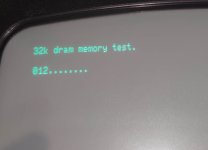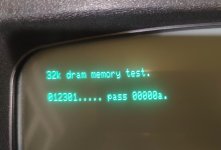That, my friend, is spot on and there is nothing on that video that I am concerned with

! Thank you.
The only thing wrong is the keyboard display codes - but that is expected at this time because UB12 is missing.
You have two (2) 6520's on the PET mainboard. The IEEE488 interface uses one at UB16. I would be inclined to remove UB16 and put that into UB12. This will allow you to test the keyboard with the PETTESTER at this stage. Wait until you get the "countdown" message. You should observe a line of 00's for the keyboard display with no keys pressed and you should see a single 1, 2, 4 or 8 display on one of the digits when you press a key. It doesn't matter which keys you press, just run across the keyboard keys from top left of the keyboard to bottom right and observe that one digit changes for each keypress.
If that is OK - then you have a working UB12 - but a missing UB16 that you need to replace.
If that doesn't work correctly, then that indicates another faulty 6520!
Dave



